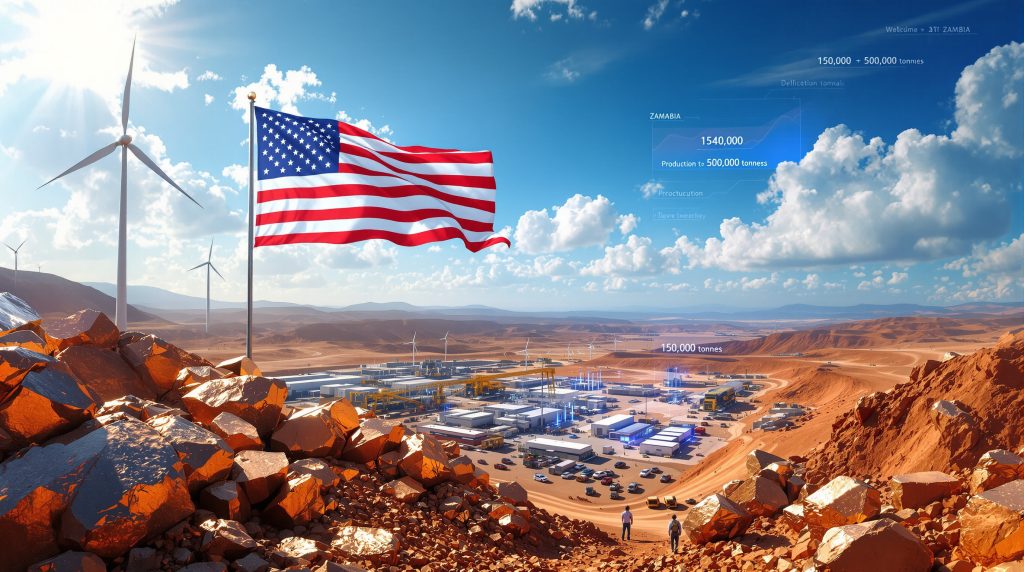The United States faces a mounting challenge in securing adequate copper price insights for its rapidly expanding technological infrastructure. Current data from the U.S. Geological Survey reveals that America imports approximately 40% of its refined copper supplies, creating strategic vulnerabilities in critical sectors. As the world's largest copper consumer yet only the third-largest producer globally, this dependency gap continues widening amid unprecedented demand growth.
The surge in copper requirements stems from multiple converging factors. Global data center electricity consumption is projected to triple from 1% to 3-4% of worldwide usage by 2030, with each facility requiring extensive copper wiring for power distribution and cooling systems. The International Energy Agency notes that renewable energy installations demand 3-4 times more copper per megawatt compared to traditional fossil fuel infrastructure.
Electric vehicle manufacturing amplifies this demand significantly. Modern EVs contain 50-100 kilograms of copper per vehicle, compared to just 10-20 kilograms in conventional automobiles. With U.S. EV sales reaching 1.8 million units in 2023 and representing 14% of total vehicle sales, the automotive sector's copper consumption continues accelerating.
The artificial intelligence boom further intensifies copper requirements. Advanced AI in mining operations computing infrastructure, data centres, and supporting electrical systems all rely heavily on high-grade copper components. This technological transformation coincides with massive grid modernisation efforts, where the American Society of Civil Engineers estimates substantial copper additions will be necessary through 2050.
Strategic Response Through CopperTech Metals Architecture
Vedanta Resources CopperTech Metals launch in November 2025 represents a systematic approach to addressing America's copper security concerns. This U.S.-domiciled company structure specifically targets the integration of Zambian copper resources into American supply chains, positioning itself within broader critical mineral resilience strategies.
The strategic framework connects Zambian copper production capabilities with American industrial requirements through several key mechanisms:
- Direct ownership and operation of world-class copper assets
- Advanced technology integration for enhanced extraction efficiency
- Streamlined supply chain pathways between African resources and U.S. manufacturing
Furthermore, Zambia's position as the world's sixth-largest copper producer, with approximately 12.7 million tonnes of copper reserves, provides substantial resource backing for this initiative. The International Copper Study Group reports that Zambian copper production reached 680,000 tonnes in 2023, demonstrating the country's established mining capabilities.
CopperTech's approach leverages existing infrastructure investments whilst planning significant capacity expansions. Consequently, the company's strategy involves building upon Vedanta's substantial capital commitments in Zambian mining operations, creating a foundation for scaled copper production targeting American markets.
Konkola Copper Mines: World-Class Asset Foundation
The Konkola Copper Mines acquisition centres on accessing one of Africa's most significant copper deposits. This integrated mining complex features established infrastructure including deep shaft operations, smelter facilities, and concentrator capabilities developed through previous investments totalling $3 billion.
Current production planning targets 140,000 tonnes of copper annually by fiscal year 2026, serving as the baseline for expansion initiatives. Moreover, the mine's proven cobalt reserves add strategic value, particularly given that approximately 70% of global cobalt production originates from potentially unstable regions in the Democratic Republic of Congo.
| Production Phase | Timeline | Annual Capacity | Investment Focus |
|---|---|---|---|
| Baseline Operations | FY2026 | 140,000 tonnes | Infrastructure optimisation |
| Phase One Expansion | By 2031 | 300,000 tonnes | Capacity enhancement |
| Future Development | Long-term | 500,000 tonnes | Advanced technology integration |
The existing infrastructure foundation includes sophisticated mining equipment and processing facilities designed for high-volume copper extraction. In addition, deep shaft access enables exploitation of high-grade ore deposits, whilst integrated smelting and concentration capabilities provide complete processing chains from raw ore to refined copper products.
At full capacity, 500,000 tonnes annually would position Konkola among the top 10 global copper producers. For perspective, Chile's Codelco produces approximately 1.7 million tonnes annually, whereas major producers like Freeport-McMoRan generate roughly 1.5 million tonnes yearly according to Vedanta's CopperTech strategy.
Technology Integration and Operational Innovation
CopperTech's strategy emphasises advanced technology deployment across mining operations. The global artificial intelligence market in mining reached $2.9 billion in 2023, with projected growth rates of 15.8% annually through 2030, indicating substantial industry momentum toward technological modernisation.
AI-Powered Resource Optimisation
The company plans implementing AI-driven systems for multiple operational aspects:
- Resource identification: Machine learning algorithms for geological modelling and orebody prediction
- Extraction optimisation: Automated systems for drilling precision and ore recovery maximisation
- Predictive maintenance: AI monitoring of equipment performance to minimise unplanned downtime
Industry data suggests that AI-driven predictive maintenance can reduce unplanned equipment downtime by 20-25% in major mining operations. However, this technology application becomes particularly valuable in deep shaft mining environments where equipment failures create significant operational disruptions.
Advanced Mining Infrastructure Development
The technological framework includes autonomous drilling systems, smart hauling equipment, and integrated safety monitoring. The International Council on Mining and Metals reports that automation and remote operation systems significantly improve both safety records and operational efficiency in modern mining operations.
Environmental monitoring technologies will integrate real-time data collection for air quality, water management, and waste processing. Consequently, these systems support sustainable mining practices whilst maintaining operational transparency for regulatory compliance.
Production Capacity Transformation Through Investment
The planned $1.5 billion investment programme aims to triple production capacity over a six-year timeline. This expansion involves multiple development phases, each targeting specific capacity milestones and operational improvements.
Phase Implementation Strategy
Current to 2026 (Baseline Establishment):
Production optimisation focuses on achieving 140,000 tonnes annually through existing infrastructure enhancement. This phase emphasises operational efficiency improvements and equipment modernisation.
2026 to 2031 (Primary Expansion):
Capacity doubling to 300,000 tonnes requires significant infrastructure additions. New processing equipment, expanded ore handling systems, and enhanced transportation capabilities form the core investment areas.
Beyond 2031 (Advanced Development):
The target of 500,000 tonnes annually involves comprehensive facility expansion and advanced technology integration. Furthermore, this phase depends on market conditions and successful completion of earlier development stages.
Global Market Positioning Analysis
Global copper mine production totalled approximately 20.1 million tonnes in 2023, with leading producers including Chile (5.2 million tonnes), Peru (2.2 million tonnes), and China (1.7 million tonnes). The global copper supply forecast indicates that CopperTech's planned capacity would represent roughly 2.5% of global production at full scale.
The strategic positioning targets supply chain integration with U.S. industrial requirements rather than commodity market competition. This approach emphasises secure, reliable copper delivery to specific sectors including renewable energy, electric vehicles, and data centre development.
Supporting American Infrastructure Modernisation
CopperTech's copper supply directly supports multiple critical infrastructure sectors experiencing rapid expansion. The renewable energy transition requires substantial copper additions across solar, wind, and energy storage installations.
Sector-Specific Copper Applications
Electric Vehicle Manufacturing:
With EVs requiring 3-4 times more copper than conventional vehicles, automotive sector demand continues accelerating. U.S. EV sales grew 50% in 2023, creating sustained copper demand growth projections through the decade.
Renewable Energy Infrastructure:
Solar installations require 50-100 kilograms of copper per megawatt, whilst wind systems need 200-500 kilograms per megawatt. Moreover, the US copper production overview shows that U.S. renewable capacity additions of 21 gigawatts in 2023 demonstrate the scale of copper requirements for clean energy transition.
Data Centre and AI Computing:
Modern data centres consume approximately 14% of U.S. electricity, with copper essential for power distribution, cooling systems, and networking infrastructure. Consequently, the AI computing boom intensifies these requirements through high-performance processing facilities.
Grid Modernisation Projects:
The U.S. Department of Energy estimates that grid modernisation requires 2-3 times more copper in transmission and distribution systems compared to existing infrastructure. In addition, smart grid technologies and renewable energy integration drive these enhanced copper specifications.
Industrial Onshoring Support
Domestic manufacturing resurgence creates additional copper demand across multiple industries. Electronic component manufacturing, advanced materials processing, and high-technology production all require reliable copper supplies for competitive operations.
Strategic mineral stockpiling initiatives and emergency preparedness planning further emphasise secure copper access. CopperTech's U.S.-domiciled structure aims to address these supply security concerns through established supply chain relationships.
Geopolitical and Economic Strategic Implications
The Vedanta Resources CopperTech Metals launch operates within complex geopolitical dynamics affecting critical mineral access. Current global copper production concentration presents strategic vulnerabilities, with Chile controlling 28% of worldwide output and Peru contributing 11%.
Bilateral Partnership Development
U.S.-Zambia bilateral trade reached $1.2 billion in 2023, with significant American investment in Zambian mining sectors historically. The CopperTech partnership aims to strengthen economic relationships through enhanced mineral cooperation and technology transfer.
Zambian copper resources provide geographic diversification from traditional suppliers, reducing dependency on regions with potential political instability. However, this diversification strategy aligns with broader Western approaches to critical mineral supply chain resilience.
Global Supply Chain Dynamics
Copper price volatility, ranging from $2.80-4.10 per pound during 2023-2024, demonstrates market sensitivity to supply disruptions and demand fluctuations. Furthermore, secure, long-term supply agreements can provide price stability for American industrial consumers.
The initiative potentially influences international copper pricing through increased supply availability and geographic distribution. Competition with other major producing nations may intensify as demand growth outpaces production capacity additions globally according to Vedanta's $1.5 billion commitment.
Supply security implications extend beyond direct copper access:
- Enhanced negotiating position for long-term supply contracts
- Reduced vulnerability to supply chain manipulation by hostile actors
- Improved strategic mineral stockpiling capabilities
- Support for allied nations' mineral security requirements
Investment Framework and Financial Projections
The $1.5 billion investment programme requires careful capital allocation across multiple operational areas. Whilst specific distribution details remain undisclosed, industry analysis suggests typical mining expansion investments focus on processing capacity, extraction equipment, and infrastructure development.
Revenue Generation Potential
At planned production levels, annual revenue potential varies significantly based on copper pricing. Using recent price ranges of $3.50-4.00 per pound:
- 300,000 tonnes (2031 target): $2.3-2.6 billion annual revenue potential
- 500,000 tonnes (future capacity): $3.9-4.4 billion annual revenue potential
These projections assume sustained copper demand growth and stable pricing conditions. However, market volatility and production cost factors will significantly influence actual financial performance.
Long-Term Investment Returns
Copper demand growth projections through 2030 support sustained pricing above historical averages. The International Energy Agency forecasts continued demand increases driven by clean energy transitions and electrification across multiple sectors.
Premium pricing opportunities exist for ethically-sourced, environmentally-responsible copper production. ESG-focused procurement by major corporations creates market differentiation possibilities for operators meeting enhanced sustainability standards.
Key financial risk factors include:
- Copper price volatility and market demand fluctuations
- Capital cost overruns during expansion phases
- Operational challenges in remote mining environments
- Regulatory changes affecting international mining operations
- Currency exchange rate impacts on dollar-denominated revenues
Environmental Sustainability and Responsible Mining
Modern mining operations face increasing environmental scrutiny and sustainability requirements. CopperTech's approach emphasises responsible extraction methodologies and community engagement throughout operational areas.
Environmental Impact Mitigation
Advanced mining technologies enable more precise extraction with reduced environmental footprints. AI-driven resource identification minimises unnecessary excavation, whilst automated systems optimise energy consumption throughout processing operations.
Water management systems incorporate recycling and treatment technologies to minimise freshwater consumption and prevent contamination of local water sources. Moreover, waste management protocols focus on tailings containment and long-term site rehabilitation planning.
Community Development Integration
Local economic development programmes aim to create sustainable benefits for Zambian communities surrounding mining operations. These initiatives include skills training, infrastructure development, and supplier development programmes supporting local businesses.
Employment creation extends beyond direct mining jobs to include transportation, maintenance, and support services. Furthermore, technology transfer opportunities provide long-term capabilities for local workforce development and economic diversification.
Clean Energy Transition Support
Copper's essential role in renewable energy infrastructure creates direct connections between mining operations and global decarbonisation efforts. Solar panels, wind turbines, and energy storage systems all require substantial copper components for optimal performance.
Circular economy principles guide recycling integration and end-of-life product management. Consequently, copper's excellent recyclability characteristics support sustainable supply chain development and resource conservation strategies.
Risk Assessment and Strategic Challenges
Large-scale mining expansions face multiple operational and market risks requiring comprehensive management strategies. Technical complexity increases significantly when scaling production across remote African mining locations.
What are the Primary Operational Risk Factors?
Infrastructure Development Challenges:
Remote mining locations require substantial infrastructure investments for reliable operations. Power generation, transportation networks, and communication systems all demand significant capital commitments and ongoing maintenance.
Technology Integration Complexity:
AI systems and advanced automation require specialised expertise and continuous technical support. Furthermore, workforce training and technology maintenance present ongoing operational challenges in developing regions.
Mining Operation Technical Risks:
Deep shaft mining involves geological uncertainties, equipment reliability concerns, and safety management complexities. Ore grade variations and geological conditions can significantly impact production forecasts and operational costs.
Market and Regulatory Considerations
Copper Market Volatility:
Global commodity markets experience significant price fluctuations driven by economic cycles, supply disruptions, and demand variations. Extended low-price periods can severely impact project economics and investment returns.
International Trade Regulations:
Export restrictions, trade disputes, and changing international relationships can disrupt supply chain operations. However, political changes in either Zambia or the United States could affect operational frameworks and market access.
Regulatory Environment Stability:
Mining regulations, environmental requirements, and taxation policies in Zambia may evolve over the project's operational lifetime. In addition, regulatory changes can impact profitability and operational procedures significantly.
Currency and Financial Risks:
Exchange rate fluctuations between U.S. dollars, Zambian kwacha, and other currencies affect operational costs and revenue realisation. Inflation, interest rate changes, and capital market conditions influence project financing costs.
Future Implications for Critical Mineral Strategy
The Vedanta Resources CopperTech Metals launch establishes precedents for American approaches to strategic mineral access through international partnerships. This model could expand to other critical materials including lithium, rare earth elements, and strategic metals essential for advanced technologies.
Strategic Resource Access Framework
Public-private partnerships combining government policy support with commercial investment create frameworks for critical mineral security. The CopperTech structure demonstrates integration possibilities between private sector capabilities and national security requirements.
Future initiatives may replicate this approach across diverse geographic regions and mineral categories. Strategic partnerships with stable, democratic nations can provide alternative supply chains reducing dependency on potentially hostile suppliers.
Long-Term Supply Chain Transformation
Manufacturing competitiveness increasingly depends on secure, reliable access to strategic materials. Companies with integrated supply chains from raw materials through finished products gain significant advantages during supply disruptions or market volatility.
The initiative supports broader industrial onshoring trends by providing secure material inputs for domestic manufacturing expansion. Moreover, strategic stockpiling capabilities and emergency preparedness improve national resilience against supply chain attacks or natural disruptions.
Technology and Innovation Integration
Advanced mining technologies developed through CopperTech operations create exportable capabilities for other strategic mineral projects. AI systems, automation technologies, and sustainable extraction methods developed in copper mining applications can transfer to other critical mineral operations.
International cooperation on mining technology development strengthens partnerships with allied nations whilst advancing global sustainability standards. Furthermore, copper investment strategies and technical collaboration create lasting relationships beyond individual mining projects.
Disclaimer: This analysis is based on company announcements and publicly available information. Production targets, investment timelines, and financial projections represent forward-looking statements subject to market conditions, operational challenges, and regulatory changes. Readers should conduct independent research and consult qualified professionals before making investment decisions related to mining operations or commodity markets.
Why Not Position Yourself Ahead of Australia's Copper Discovery Boom?
Discovery Alert provides instant notifications on significant ASX mineral discoveries, powered by its proprietary Discovery IQ model. Explore how historic copper discoveries have delivered exceptional returns by visiting Discovery Alert's dedicated discoveries page, then begin your 30-day free trial to gain real-time market-leading insights.




